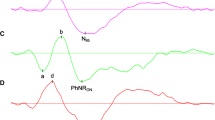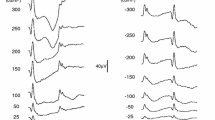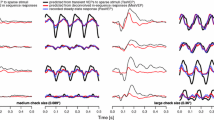Abstract
The spatial response function of the electroretinogram (ERG) to contrast checkerboard pattern reversal at several check sizes was determined at a fixed contrast. The influence of the rate of modulation on the spatial response function was assessed: Reversing square wave patterns were presented at eight temporal frequencies ranging from 1 to 25 reversals per sec; The waveform consisted of an initial positive and a subsequent negative deflection. Irrespective of the temporal frequency, the spatial response function of the positive component did not show a spatial tuning. The amplitude of the negative component exhibited a pronounced attenuation of the response at check sizes larger than optimal. Mean maximal amplitude was found at an optimal check size between 25 and 50 min of arc. A distinction between a positive or negative component was not made for temporal frequencies higher than 10 reversals per sec, since the wave-form at these modulation rates consisted merely of a sinusoidal steady-state response. The spatial response function obtained at 14 reversals per sec; resembling that of the negative component, exhibited a prominent spatial tuning. The results demonstrate that the pattern ERG has at least two components: a positive component which is not specific to changes in retinal distribution of contrast, followed by a negative wave showing spatial tuning across temporal frequency.
Similar content being viewed by others
References
Arden GB, Carter RM, Hogg C, Siegel IM and Margolis S (1979) A gold foil electrode: extending the horizons for clinical electroretinography. Invest Ophthalmol Vis Sci 18:421–426
Armington JC (1974) The electroretinogram. New York, Academic Press
Armington JC, Corwin TR and Marsetta R (1971) Simultaneously recorded retinal and cortical responses to patterned stimuli. J Opt Soc Am 61:1515–1521
Baker CL Jr and Hess RF (1984) Linear and nonlinear components of human electroretinogram. J Neurophysiol 51:952–967
Dawson WW, Maida TM and Rubin ML (1982) Human pattern-evoked retinal responses are altered by optic atrophy. Invest Ophthalmol Vis Sci 22:796–803
Enroth-Cugell C and Robson JG (1966) The contrast sensitivity of retinal ganglion cells of the cat. J Physiol (Lond) 187:517–552
Enroth-Cugell C, Robson JG, Schweitzer-Tong DE and Watson AB (1983) Spatiotemporal interactions in cat retinal ganglion cells showing linear spatial summation. J Physiol. (Lond) 341:279–307
Granit R (1933) The components of the retinal action potential in mammals and their relation to the discharge in the optic nerve. J Physiol. (Lond) 77:207–239
Hess RF and Baker CL Jr (1984) Human pattern-evoked electroretinogram. J Neurophysiol 51:939–951
Korth M (1981) Human fast retinal potentials and the spatial properties of a visual stimulus. Vision Res 21:627–630
Maffei L and Fiorentini A (1981) Electroretinographic responses to alternating gratings before and after section of the optic nerve
Odom JV, Maida TM and Dawson WW (1982) Pattern evoked retinal response (PERR) in human; effects of spatial frequency, temporal frequency, luminance and defocus. Curr Eye Res 2:99–108
Riemslag FCC, Ringo JL, Spekreijse H and Verduvn Lunel H (1983) The distinction between luminance and spatial contrast components in the pattern ERG. Doc Ophthalmol Proc Ser 37:255–264
Schuurmans RP and Berninger T (1984) Luminance and contrast responses recorded in man and cat. Doc Opthalmol Proc Ser (in press)
Sokol S, Jones K and Nadler D (1983) Comparison of the spatial response properties of the human retina and cortex as measured by simultaneously recorded pattern ERGs and VECPs. Vision Res 23:723–727
Spekreijse H, van der Tweel LH and Zuidema T (1973) Contrast evoked responses in man. Vision Res 13:1577–1601
Author information
Authors and Affiliations
Rights and permissions
About this article
Cite this article
Berninger, T., Schuurmans, R.P. Spatial tuning of the pattern ERG across temporal frequency. Doc Ophthalmol 61, 17–25 (1985). https://doi.org/10.1007/BF00143211
Issue Date:
DOI: https://doi.org/10.1007/BF00143211




